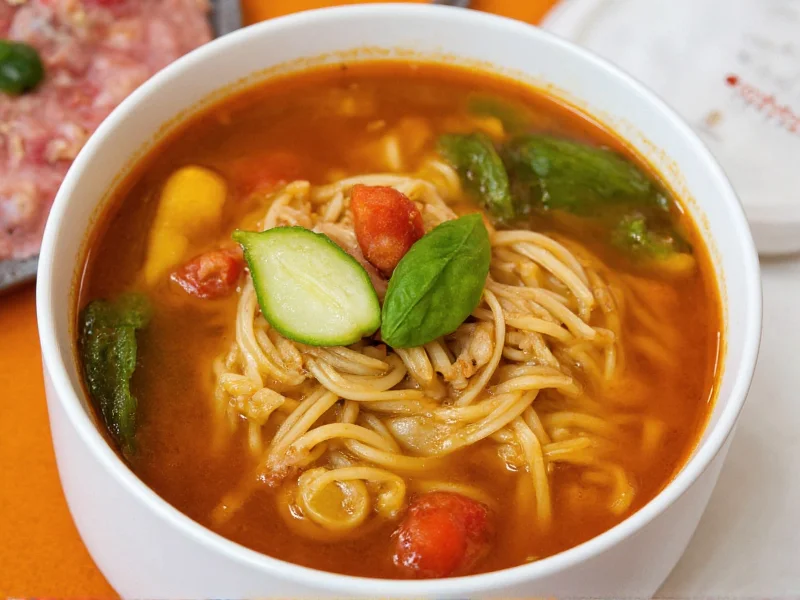Maggi soup products have become kitchen staples across continents, offering convenient meal solutions with preparation times under 5 minutes. The brand's signature umami-rich flavor comes from a carefully balanced blend of ingredients that enhance soups, stews, and various dishes without requiring extensive cooking expertise. Understanding what makes Maggi soup distinctive helps home cooks leverage its potential while making informed choices about usage.
The Origins and Evolution of Maggi Soup Products
Swiss entrepreneur Julius Maggi developed the first Maggi soup products in the late 19th century, seeking affordable, nutritious meal solutions for industrial workers. His innovation of dehydrated soup mixes and seasoning cubes revolutionized home cooking by significantly reducing preparation time while maintaining flavor complexity. The Maggi brand entered global markets through strategic acquisitions, most notably by Nestlé in 1947, which expanded production while preserving the core formulation principles established by Maggi himself.
Early Maggi soup products focused on vegetable-based formulations that provided essential nutrients during periods of food scarcity. The distinctive yellow packaging became recognizable worldwide as the product line expanded to include regional variations catering to local palates while maintaining the signature umami foundation. This adaptability explains Maggi soup's enduring popularity across diverse culinary traditions.
Global Variations and Regional Adaptations
Maggi soup products demonstrate remarkable cultural adaptation while maintaining core characteristics. The brand offers region-specific formulations that respect local culinary preferences while delivering the consistent umami experience consumers expect. Consider these notable regional variations:
| Region | Popular Varieties | Distinctive Features |
|---|---|---|
| Europe | Vegetable, Chicken, Tomato | Milder seasoning, lower sodium content |
| South Asia | Tomato Shorba, Vegetable Manchow | Bolder spices, chili notes, higher umami intensity |
| Africa | Chicken, Vegetable, Seafood | Enhanced with local herbs, adaptable to traditional stews |
| Latin America | Verduras, Pollo, Ajo | Garlic-forward profiles, compatible with regional dishes |
These regional adaptations showcase Maggi soup's versatility as a culinary foundation rather than merely a convenience product. Home cooks worldwide incorporate Maggi soup into traditional recipes, using it as a flavor enhancer that respects cultural cooking practices while reducing preparation time.
Ingredients and Nutritional Profile Analysis
Understanding Maggi soup ingredients helps consumers make informed choices about incorporating these products into their diets. The core components typically include:
- Hydrolyzed vegetable protein (primary umami source)
- Salt (sodium content varies by region)
- Dehydrated vegetables (onion, carrot, celery)
- Spice blends (region-specific formulations)
- Natural flavor enhancers
- Anti-caking agents (in powdered/cube forms)
Nutritionally, Maggi soup products serve as concentrated flavor sources rather than complete meals. A single serving (typically 5-8g) contains approximately 10-20 calories, with sodium content ranging from 300-600mg depending on the variety and regional formulation. The products contain no significant protein, fat, or carbohydrate content in standard serving sizes, functioning primarily as seasoning agents.
Health-conscious consumers can modify maggi soup preparation by reducing the recommended serving size, adding fresh vegetables and proteins, and using reduced-sodium versions where available. This approach maintains flavor benefits while creating more nutritionally balanced meals.
Practical Applications in Home Cooking
Maggi soup products extend far beyond their intended use as instant soups. Experienced home cooks leverage these products as versatile flavor foundations for various culinary applications:
Enhancing Everyday Cooking
Adding half a Maggi cube or teaspoon of liquid seasoning to rice water creates flavorful seasoned rice. Incorporating Maggi soup base into lentil dishes enhances depth without overpowering traditional flavors. Many professional chefs use Maggi soup products in small quantities to boost umami in sauces and braises, demonstrating how maggi soup preparation time can be minimized while maximizing culinary results.
Creating Complete Meals
Transforming Maggi soup into substantial meals requires strategic additions. For a complete vegetable maggi soup recipe, consider:
- Prepare Maggi soup according to package instructions
- Add 1 cup mixed vegetables (carrots, peas, corn)
- Incorporate 100g cooked protein (chicken, tofu, or chickpeas)
- Finish with fresh herbs and a squeeze of lemon
This approach transforms a simple seasoning product into a nutritionally balanced meal while maintaining the convenience factor that makes maggi vegetable soup recipe adaptations so popular worldwide.
Addressing Common Misconceptions
Several misconceptions surround Maggi soup products that deserve clarification based on factual information. The notion that Maggi soup contains excessive MSG requires context—while it does contain natural glutamates from hydrolyzed protein, the levels are comparable to many traditional fermented foods. Regarding is maggi soup healthy concerns, the products function as seasonings rather than complete foods, making their health impact dependent on overall dietary patterns and usage quantities.
Another common misunderstanding involves maggi soup vs instant noodles comparisons. While both fall under the Maggi brand umbrella, they serve different culinary purposes—soup products function as seasonings and bases, while noodles represent complete meal solutions. Understanding this distinction helps consumers make appropriate choices for their cooking needs.
Maximizing Flavor While Minimizing Sodium
Consumers seeking to enjoy Maggi soup benefits while managing sodium intake can implement several practical strategies. Using only half the recommended serving provides sufficient flavor enhancement with reduced sodium. Combining Maggi soup with aromatic bases like sautéed onions and garlic creates more complex flavors that allow for further reduction. Adding acidic elements like lemon juice or vinegar at the end of cooking balances flavors, making lower-sodium preparations taste more complete.
For those exploring how to make maggi soup more substantial, incorporating fresh ingredients transforms these products into nutritionally balanced meals. Adding leafy greens, lean proteins, and additional vegetables creates restaurant-quality dishes with minimal effort. This approach respects the convenience factor while addressing nutritional considerations that concern many modern consumers.











 浙公网安备
33010002000092号
浙公网安备
33010002000092号 浙B2-20120091-4
浙B2-20120091-4